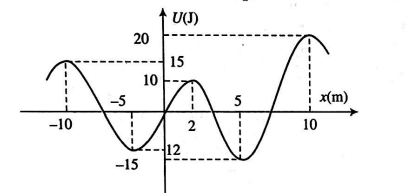Q.
In the figure below, the variation of potential energy of a particle of mass $m=2\, kg$ is represented w.r.t its $x$-coordinate. The particle moves under the effect of the conservative force along the $x$-axis. Which of the following statements is incorrect about the particle?
Work, Energy and Power
Report Error
Solution:
If the particle is released at the origin, it will try to go in the direction of force.
Here $d U / d x$ is positive and hence force is negative; as a result, it will move towards negative $x$-axis.
When the particle is released at $x=2+\Delta$, it will reach the point of least possible potential energy $(-15\, J )$ where it will have maximum kinetic energy.
$\frac{1}{2} m v_{\max }^{2}=25$
$v_{\max }=5\, m s ^{-1}$
The particle will now perform oscillatory motion with $x=5$ as mean position.
In (c), $E_{i}=u_{i}+k_{i}=15+6=21\, J$
At $x=10, U_{f}=20$
$K_{f}=1 \neq 0$
So the particle crosses $x=10$.
Questions from Work, Energy and Power
Physics Most Viewed Questions
1. If $E$ and $G$ respectively denote energy and gravitational constant, then $\frac{ E }{ G }$ has the dimensions of:
NEET 2021
Physical World, Units and Measurements
2. The de Broglie wavelength of an electron moving with kinetic energy of $144 \,eV$ is nearly
NEET 2020
Dual Nature of Radiation and Matter
3. A car starts from rest and accelerates at $5\, m / s ^{2}$ At $t=4\, s$, a ball is dropped out of a window by a person sitting in the car. What is the velocity and acceleration of the ball at $t =6\, s$ ? (Take $\left. g =10\, m / s ^{2}\right)$
NEET 2021
Motion in a Straight Line
Latest Updates
- JEE Main 2023 February 25th Shift 1 Morning
- JEE Main 2023 February 25th Shift 2 Evening
- JEE Main 2023 January 31st Shift 1 Morning
- JEE Main 2023 January 31st Shift 2 Evening
- JEE Main 2023 January 30th Shift 1 Morning
- JEE Main 2023 January 30th Shift 2 Evening
- JEE Main 2023 January 25th Shift 1 Morning
- JEE Main 2023 January 25th Shift 2 Evening
- JEE Main 2023 January 24th Shift 1 Morning
- JEE Main 2023 January 24th Shift 2 Evening
- JEE Main 2023 February 1st Shift 1 Morning
- JEE Main 2023 February 1st Shift 2 Evening
- JEE Main 2022 July 25th Shift 1 Morning
- JEE Main 2022 July 25th Shift 2 Evening
- JEE Main 2022 July 26th Shift 1 Morning
- JEE Main 2022 July 28th Shift 1 Morning
- JEE Advanced 2022 Paper 2
- JEE Advanced 2022 Paper 1
- JEE Advanced 2021 Paper 2
- JEE Advanced 2021 Paper 1
- JEE Advanced 2020 Paper 2
- JEE Advanced 2020 Paper 1
- NEET 2022 Physics Answer Key
- NEET 2022 Chemistry Answer Key
- NEET 2022 Botany Biology Answer Key
- NEET 2022 Zoology Biology Answer Key
- NEET Rank Predictor 2023